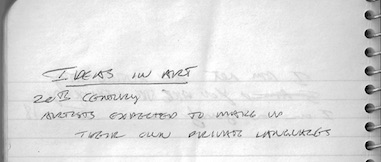
I first encountered Craig Owens in early September, 1983. It was a few weeks before my eighteenth birthday and I was starting my third year of course work at the School of Visual Arts in New York. I moved to New York in the fall of 1981 after dropping out of high school, and started at SVA a few months later. My application portfolio consisted of ceramics, stained glass, and drawings of flowers. At SVA I immersed myself in painting, influenced indiscriminately by the neo-expressionist, post-pop, and Pictures work I was seeing in New York at the time. But in the fall of 1983, I was feeling lost, alone, and thinking about dropping out. I signed up for a required seminar called “Ideas in Art.” The seminar was taught by a range of adjunct faculty every year and I signed up for the course taught by Roberta Smith, whose name I knew because I read her art criticism in the Village Voice. Much to my surprise, I found a tall, blond man at the front of the room instead: Smith had to drop the class and was replaced by Craig Owens. The other students in the class included people I didn’t know yet but who would become close friends and artistic colleagues: Gregg Bordowitz, Tom Burr, and Mark Dion, as well as Fareed Armaly, Daphne Fitzpatrick, Collier Schorr, and Marina Zurkow. (After the class ended, some of us even formed a reading group, which Craig visited a few times.)
What I remember most from that first class was Craig’s reflexive, Foucauldian critique of his own power in the classroom. Having grown up in a counter-culture family that held “question authority” as a motto, I was sold. Craig was full of energy and curiosity and seemed to take great pleasure in his engagement with critical theory, which was wide-ranging. I remember him describing himself as an “intellectual floozy.” At the same time, he always applied theory to concrete and immediate phenomena. Beyond exposing us to the content of critical theory, he demonstrated a way of engaging with theory outside of the academic context of specific disciplinary frameworks and in connection with lived experience. Despite his evident pleasure and excitement in intellectual engagement, Craig never promoted theory for theory’s sake. He always related theory to practice. For Craig, theory was a toolbox for practice, whether artistic or intellectual, not an end in itself. The aims were always social and political: practice never should be reduced to an illustration of theory and theory never should be reduced to simply justifying and legitimizing practice. While my sketchy notes reflect Craig’s focus on linguistic models, it was his Foucauldian, Derridian, and psychoanalytic feminism that resonated most with me. By the time the course ended, my library had expanded to include Lacan’s Four Fundamental Concepts of Psychoanalysis, Foucault’s Power/Knowledge, Derrida’s Speech and Phenomena, and Baudrillard’s For a Critique of the Political Economy of the Sign, among other books, and a collection of essays copied from October, Screen, Yale French Studies, and Signs, among other academic journals, as well as Craig’s own essays from Art in America and elsewhere. I began looking seriously at the artists Craig wrote about: Jenny Holzer, Mary Kelly, Barbara Kruger, Allan McCollum, and Martha Rosler, among others. My work and thinking about art changed radically.
With Craig’s encouragement, I applied to the Whitney Independent Studies Program that fall and, with his support, I was accepted. While at the Whitney Program, I continued to sit in on Craig’s classes at SVA. For an assignment in his art criticism class in the fall of 1984, I proposed to write about Louise Lawler’s work. Very little had been written about Louise’s work at that time, so Craig suggested that if I wrote something serious he might be able to get it published in Art in America. My spelling was terrible, my grammar shaky, and I could barely type, but I spent much of that winter and spring working on an essay that was finally published in June 1985 with the title “In and Out of Place.”1 Craig patiently worked through four drafts of the essay with me. In the process, he taught me how to write.
There is no doubt in my mind that I would not be in the art field today if I had not happened into Craig’s class. I would have dropped out of art school without finding my way to the Whitney ISP, to psychoanalytic and queer feminism, to institutional critique and reflexive analysis; without finding early inspiration and support from the older artists Craig counted as friends; and without believing myself capable of publishing essays and developing performances for museums. Craig enabled and empowered a generation of young artists to think and work critically, providing support well beyond the boundaries of the classroom.
DOCUMENTS
- 1. Andrea Fraser, “In and Out of Place,” Art in America 73, no. 6 (June 1985): 122–29; reprinted in Museum Highlights: The Writings of Andrea Fraser, ed. Alexander Alberro (Cambridge: The MIT Press, 2005), 17–28.